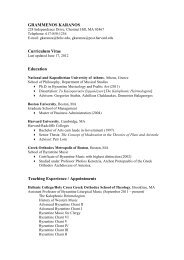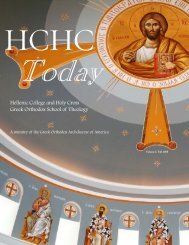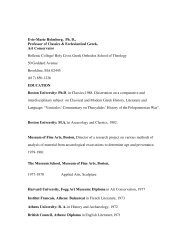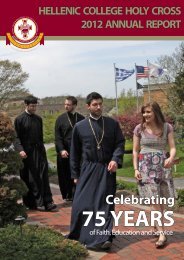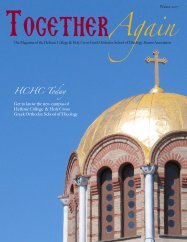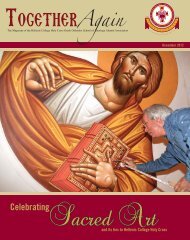GREEK, ROMAN AND BYZANTINE OBJECTS ... - Hellenic College
GREEK, ROMAN AND BYZANTINE OBJECTS ... - Hellenic College
GREEK, ROMAN AND BYZANTINE OBJECTS ... - Hellenic College
Create successful ePaper yourself
Turn your PDF publications into a flip-book with our unique Google optimized e-Paper software.
6<br />
2. Bronze Reliquary Cross-Pendants<br />
The cross-shaped pendants, or engolpia, derive from early Christian metal crosses<br />
that were worn around the necks of believers and often had small openings to<br />
enclose fragments of the True Cross, some other relic, or various blessed objects.<br />
The majority of these early crosses, however, were not meant to be reliquaries.<br />
These early crosses bore either decorative patterns or some image of the crucified<br />
Christ or other holy figures. After the first Iconophile victory of 787, the role of<br />
personal, historiated phylacteries, or cross-pendants, took on a great significance<br />
among the supporters of holy images as a visual expression of their Orthodoxy,<br />
especially high-ranking individuals such as Patriarch Nikephoros I (806-815).<br />
These phylacteries usually bore an image of the crucified Christ, the Virgin,<br />
saints or images from the life of Christ. They were constructed in halves and<br />
joined by a hinge and locking device so that they could be opened to insert either<br />
a fragment of the True Cross, some other sacred relic, or blessed object. They<br />
were worn as an amulet whereby the owner expressed not only their support of<br />
holy images but also their belief in the protective powers of the sign of the Cross<br />
and relics, all sacred objects supported by the Iconophiles.<br />
Historiated reliquary cross-pendants were produced in various precious<br />
metals such as the following ninth-century examples: gold (the Pliska cross, in<br />
Sofia), silver (the Vicopisano cross, in Pisa) and enamel work (the Beresford-<br />
Hope cross, in London). But the historiated reliquary cross-pendant was also<br />
mass-produced in bronze in workshops throughout the Byzantine Empire from<br />
the ninth to the twelfth century. Hundreds of these more modest examples<br />
survive and are found in many museum and private collections. Their large<br />
number give evidence to the popular piety which stimulated the production of<br />
these bronze reliquary crosses and their owners’ trust in the efficacy of the<br />
protective and healing powers of the Cross, images of Christ and the saints, and<br />
holy relics in the post-Iconoclastic centuries



